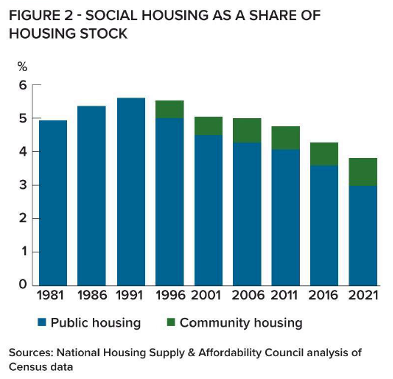Precedent project finance deals
The Federal Government’s HAFF is not only of size and scale to provide a meaningful impact on social and affordable housing supply, it is also attracting significant interest from providers of private capital (both debt and equity) and the commentariat. The first round of applications attracted bids from 37 CHPs totalling 22,600 homes, worth A$13.8bn, well exceeding the nominal first round cap of 8,000 homes.
While the HAFF may be most prominent in public discourse, there are limited recent local precedents for privately financed projects in the sector. Australia remains behind markets such as the United Kingdom and the nation is still maturing models that can be delivered at scale with investment and finance from the private sector.
GLM2 case study – Most recently Victoria has successfully closed its first two GLM projects, with consortia led by sponsors, Tetris Capital and Abrdn and financed by private sector lenders, Sumitomo Mitsui Banking Corporation (SMBC) and ANZ, as well as Federal Government policy lender Housing Australia.
Speaking about GLM2, Abrdn’s head of infrastructure funds, Bill Haughey, said: “Abrdn has been investing into the social housing space for over two decades, facilitating the build or refurbishment of over 10,000 social and affordable properties through PPP and similar models. Whilst housing may not be as technically complex to construct as light rail systems or energy from waste facilities, it remains important to ensure we have construction and operating partners with the appropriate credit quality and expertise to deliver defect-free housing which is robust and managed to a high quality, to stand the test of time in a social and affordable environment.
“ESG is an important consideration when investing and housing is no exception – we consider providing new homes with a green star 5-star rating and an aspirational average NatHERs rating of 6 or higher is desired. We want to ensure tenants not only have a nice home in which to live but one which is affordable from a heating and cooling perspective.”
When considering lending decisions, banks such as SMBC take comfort from the experience of sponsors such as Abrdn and Tetris. SMBC agrees with Abrdn’s focus on the credit quality of consortium construction partners. Both GLM1 and 2 are being built by D&C contractor, Icon Construction.
Rhys Gilhome, new business manager for Icon Construction in Victoria, said: “Australia is grappling with a persistent gap between housing supply and demand, accentuated by rapid urbanisation and population growth. This imbalance underscores the urgent need for innovative solutions to tackle the affordability crisis, particularly in urban hubs like Melbourne.
“Within this context, PPP finance emerges as a potent tool for leveraging private capital to address public infrastructure needs, including social housing. The GLM projects exemplify successful PPP ventures, where private sector expertise and capital are harnessed to deliver essential housing infrastructure.
 “The GLMs involve various housing types, including low to mid-rise construction, catering to various income levels within the community. By leveraging ground lease arrangements and combining public and private resources, the GLMs aim to provide sustainable and inclusive housing options, addressing the pressing need for affordable accommodation in Australia’s urban centres,” said Gilhome.
“The GLMs involve various housing types, including low to mid-rise construction, catering to various income levels within the community. By leveraging ground lease arrangements and combining public and private resources, the GLMs aim to provide sustainable and inclusive housing options, addressing the pressing need for affordable accommodation in Australia’s urban centres,” said Gilhome.
“The projects offer a sustainable financing mechanism for social housing development, thereby alleviating financial burdens on governments and enhancing project viability. Notably, GLM2 with the involvement of SMBC, signifies the convergence of private sector capital and institutional expertise in driving housing PPPs initiatives forward.
“In social housing PPPs, where private sector involvement is crucial, the financial strength of construction companies plays a pivotal role. A robust balance sheet signifies the ability to navigate market uncertainties, meet financial obligations, and instill confidence among stakeholders. Construction companies with strong financial credentials, such as Icon, are better positioned to undertake social housing PPP projects effectively. They can better support project risks, manage costs efficiently, and attract favourable financing terms from lenders and investors,” he said.